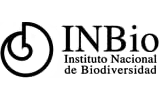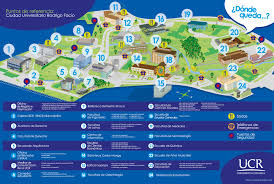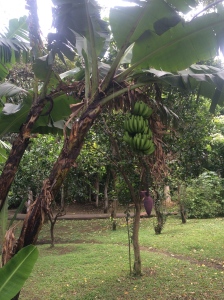¡Bienvenidos a Costa Rica!/Welcome to Costa Rica!
Pure Michigan to Pura Vida
By December 28th everyone has arrived to San Jose, Costa Rica and are ready for our first day.
Location:

Picture provided by http://www.enchanting-costarica.com/activities/san-jose-a-small-look/
San Jose is the capital city of Costa Rica, located in the center of the country, and is one of its most populated regions. In the city of San Jose, traveling is very easy because many of the roads are paved, unlike some less-developed areas throughout the country. San Jose is described as “the cultural hub of the country” because it contains both a traditional Central American city and cosmopolitan urban center. This provides an array of activities and attractions.(1)
San Jose was founded in 1737. Though through the years San Jose has been transformed into the Latin American metropolis it is today, the first thing you see when driving through the city are the rows of working coffee plantations that are responsible for San Jose’s thriving success.(1)
Our first stop of the day is the National Biodiversity Institute of Costa Rica.

Picture provided by http://www.inbio.ac.cr/en/

Blue-Sided Leaf Frog at National Biodiversity Institute in Costa Rica Photo provided by https://blogs.state.gov/stories/2013/04/22/saving-lives-livelihoods-and-life
The National Biodiversity Institute of Costa Rica was established in 1989 to gather knowledge of the country’s unique biodiversity and to promote its sustainable use. The institute believes “the best way to conserve biodiversity is to study it, value it, and utilize the opportunities it offers to improve the quality of life of human beings.”(2)
In the afternoon we will be visiting the National Museum of Costa Rica.

Located in the Bellavista Fortress in San Jose. The fortress was built in 1917 and was originally a military barracks Picture provided by tourism-506.blogspot.com
Museo Nacional de Costa Rica contains information on the Natural History, Anthropology, Archaeology and History of Costa Rica. We will have the opportunity to explore Costa Rica’s past all afternoon, until we head over to Universidad de Costa Rica.(3)
While at Universidad de Costa Rica, we will receive a tour of the campus.

Picture provided by http://eng.ucr.ac.cr/

Picture provided by http://eng.ucr.ac.cr/
Tentative Event Scheduled: Bull Fight in the evening.
Bull fighting is a popular form of entertainment in Costa Rica. Costa Rican bullfighting differs from the Spanish form. Instead of aiming to kill the bull, the challenge is to avoid it! Participants enter the ring only to dodge the charging bull. Personally, I very much prefer this variation! (4)

Bullfighting in Zapote, San Jose Picture provided by http://www.costaricantimes.com
Our Day
We began our day at InBioparque, the National Biodiversity Institute of Costa Rica. Here we watched a video that informed us of InBio’s mission: identify, describe and share all of Costa Rica’s biodiversity. This is a large task due to the fact that Costa Rica is home to over 500,000 different species! Costa Rica makes up about 6% of the Earth’s land, but is home to more than half of the known species. This vast array of organisms is due to the fact that Costa Rica is on a land bridge connecting North and South America that was formed by moving tectonic plates. This allowed the movement of species from North to South and South to North America. InBio uses their bio-prospecting research to to discover new medicinal uses of plants, observes flocks of birds to study climate change, and educates the public about sustainability and species protection. On a tour through InBio’s constructed, premature humid forest we were able to see just a small fraction of the species Costa Rica offers.
Photos taken at InBioparque
Gracias a InBioque por una gran visita!
After our visit to InBio, we took a short bus ride to the National Museum of Costa Rica, which is located in the city of San Jose. At the museum we discover much about Costa Rica’s history, specifically clues on what the environment means to native Costa Ricans. This knowledge is very important to have and take into consideration when engineering in a different country.
Following our visit to the National Museum of Costa Rica, our group headed over to the main campus if Universidad de Costa Rica and met up with 4 Costa Rican students who are joining us on the trip. At the Universidad we were given tours of the campus and learned about the life of a Costa Rican student. It was very interesting comparing their experiences to our own back at MSU. Here in Costa Rica the university is free to attend, this fact alone exhibits a huge difference between universities in the two countries!

Statue Rodrigo Facio, President of la Universidad de Costa Rica (1952-1961) in front of the main library
The visit to la Universidad concluded our first day in Costa Rica, but the night was still young, and we were given the opportunity to attend a bull fight in San Jose. This is an experience I will never forget. It was nothing that I could ever imagine. Hundreds of Costa Rican men (and a few women) entered a circular arena and awaited an angry, charging bull. When the bull entered the arena everyone scrambled, if the bull got too close to a group of people they would jump over the arena wall in order to be protected from the bull. There was singing and dancing all throughout the bleachers as people watched the events, but our section was the loudest, and we were awarded with prizes such as jerseys, calendars and purses for our spirit! This is a true Costa Rican tradition I will never forget!
Each of the locations we visited today gave us an idea of the relationship Costa Ricans have with the environment. While visiting InBio, the importance of educating people on the vast diversity of Costa Rica and the benefits it has to offer to people medicinally and educationally. The natural history museum within the National Museum of Costa Rica provided us with a historical relationship between native Costa Ricans and the environment. We learned that there are very strong spiritual and cultural bonds between the two. Ecosystems engineering focuses on the proper, least invasive approach needed to solve a problem through the use of natural system treatments. Once you have a grasp on the importance the environment has on a community, you are able to successfully create a solution that will be accepted.
Additional Links:
What a day!
Bibliography:
(1) Traveler’s guide to San Jose, Costa Rica














December 27, 2014 at 10:47 pm
What percentage of Costa Ricans live in San Jose?
LikeLike
December 30, 2014 at 12:56 am
According to the population statistics found at http://www.costalaw.com, approximately 33% of Costa Ricans live in the providence of San Jose and %7 live in the city of San Jose (http://www.costaricalaw.com/Demographics-and-Population/population-statistics.html). According to wikipedia, the rate of urbanization estimated within 5 years is expected to be 2.3% per year.
LikeLike
December 30, 2014 at 6:22 pm
This is very interesting considering San Jose is not the biggest of the seven provinces located in Costa Rica yet nearly a third of the people live in it! It is also interesting because it is in the central area of the country and not directly on one of the coasts which in America it is typically for big cities to be on the coast when they are close to water which is probably due to the history they may have of trading. When we were in the city though you could definitely tell it is a highly populated area just by the amount of people we saw walking and driving around.
LikeLike
December 29, 2014 at 12:21 pm
Great post and pictures – love the group picture!!!!
LikeLiked by 1 person
January 2, 2015 at 12:13 am
Great write-up Aubrey, this was such a great day!
I took a few notes at the InBio station that I thought I might share. There was a wonderful presentation from a young man who was our guide in the park (he was also able to point out spiders, sloths, and iguanas). He showed us a video and answered questions. One thing that particularly interested me was a database that catalogues characteristics of different species in Costa Rica. They hope to create incentives for protecting wildlife. If there is a database of all the beneficial potentialities associated with flora and fauna, it will be economical to preserve them and implement sustainable use those resources.
He gave a few examples, and here are some of them–
Green Fluorescent Protein (http://www.conncoll.edu/ccacad/zimmer/GFP-ww/GFP-1.htm) Follow link for more information!
This protein can be used to mark pieces of DNA sequences so they can be studied. There are some great photographs in the “cool uses” section of the website. This protein can be found in some of the aquatic life off of Costa Rican shore.
I did not get the name of the other chemical or the exact tree that it is extracted from, but the bark is processed to make a potent digestion aide. Before, people would process the bark with their own method. It required much time and effort and the final product was very hard to consume because of poor taste in its tea. With modern processing methods, the active ingredients can be refined efficiently and made into a pill which is easy to take.
These are too of the many examples. Here is another blog with more information on this area of study, http://jrscience.wcp.muohio.edu/FieldCourses00/PapersCostaRicaArticles/MedicinalPlantsintheRainfA.html.
This is inspiring because of the ingenuity of the modern scientists and the recognition of the ingenuity of the native peoples of Costa Rica. The rain forest has immense potential for pharmaceutical research, and the native people’s vast knowledge of their land and their knowledge of the value and interconnectedness of the world can lead to great breakthroughs in modern science.
LikeLike
January 2, 2015 at 2:54 am
As John said, good entry Aubrey!
INBioparque was a very good place to kickstart our trip. The institute is nonprofit and really wants to promote the importance and awareness of Costa Rica’s biodiversity. The slogan INBio uses is “naturally a commitment”, and it was very apparent that this is being portrayed in every aspect of the park. INBio is very big into bio-prospecting – which is defined as finding new compounds for pharmaceuticals based on the countries biological resources. Currently, INBio has over 4 million specimens that are available for researchers around the world for the purpose of bettering mankind.
The tree John mentioned in the above comment referring to the digestion aide is called the Bitter Wood tree, or Picrasma excelsa. For more information on this wood and its benefits, you can visit the following link. http://www.herbalextractsplus.com/bitter-wood.html
The National Museum of Costa Rica was very interesting because it gave us a chance to understand this countries past in order to see how they reached their current state. It is important to understand the culture and ways of a country you are visiting, whether it be for work or pleasure. I found it very interesting that this museum was located in an old fortress used in one of Costa Rica’s civil war. The museum even had left bullet holes in the outside of the museum to be reminded of the civil war this country endured in the 1940’s. This civil war was the war that resulted in the removal of the Costa Rican army. The museum is set up so when you walk in a counter clockwise direction, you are able to learn about Costa Rica’s history from when Costa Rica was inhabited by the first humans to current times. My favorite collection was the room filled with gold artifacts found from ancient civilizations that they used as a symbol of authority and power. The artifacts were so beautiful and it was fun to see how much importance the natives put on these accessories as they were full with detail. This museum is definitely one I would recommend to people visiting San Jose.
LikeLike